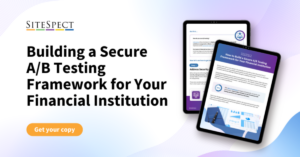5 Areas to Leverage AI in Your A/B Testing & Experimentation Process
By Paul Bernier
October 17, 2023
Share
Using the power of Artificial Intelligence (AI) is not just a passing trend; it’s a strategic advantage. And one you may have not realized you can leverage in your A/B testing process.
With over 1 million users engaging with ChatGPT within the first 5 days of launch and a projected CAGR of 37.3% for AI through 2030, there’s no denying AI is transforming the way we work and make decisions. While there are a few things to be aware of, it may be time for you to bring this powerful tech into your A/B testing and experimentation strategy. But before we dive in, there are a few things you should take note of:
- Make sure to check your company’s policy around generative AI.
- Always double-check the facts. The tools mentioned in the blog are great, but they still require human validation.
- Learning generative AI is a process that will take some time to warm up to.
In this blog, we’re looking at five key areas where AI can be a game-changer, helping you boost your A/B testing efforts to unlock valuable insights. Whether you’re a marketer, a product manager, or an “average Joe” looking to perform A/B tests, you’ll learn new ways you can leverage AI to optimize and enhance your experiments—for greater success.
Area #1 – Develop & Validate New Ideas
Ideation is the very first step in the A/B testing and experimentation process. But many struggle to consistently develop fresh ideas for testing.
You can streamline the ideation phase by simply asking an AI tool (like ChatGPT) to help you out. The more you work with it and develop your prompts, the better the results you’ll get out of it. Whether it’s identifying potential website improvements, email marketing strategies, or product feature enhancements, AI can provide the initial spark to kick off the creative process.
AI can even assist in the validation process by predicting the potential impact of your proposed changes. When you leverage AI, you can simulate how different variations of experiments might perform before actually implementing them, saving valuable time and resources. This predictive capability enables you to prioritize the most promising ideas and focus efforts where they are likely to have the greatest impact. Additionally, AI can help identify unexpected interactions between variables and user segments, ensuring your experiments are comprehensive and cover all potential scenarios.
Integrating AI into the development and validation of new ideas can enhance the effectiveness and efficiency of your A/B testing and experimentation process. This will ultimately lead to more informed decision-making and better outcomes for your organization.
Area #2 – Imagery Generation
There’s simply no denying it. The visual aspect of your content plays a huge role (arguably the biggest) in user engagement and conversion rates.
This is where AI, particularly generative models like DALL-E, Bing Image Creator, and Midjourney, can be a game-changer. You can use these cutting-edge tools to ideate, iterate on or even generate entirely new imagery for your A/B tests.
One of the key advantages of using generative AI for image generation is its ability to rapidly produce tons of graphic variations, ensuring you have a diverse set of images to test in your A/B experiments. These models can understand your creative brief and generate imagery that aligns with your brand identity and messaging.
This approach allows you to run A/B tests with a wider range of visual elements, helping you identify which images and designs are most effective in achieving your desired outcomes. As you run more tests and collect more data, using this AI technology will only improve your process over time.
Whether you’re optimizing the visual elements of your website, header graphics for email marketing campaigns, or product listings—generative AI can help you create eye-catching visuals that resonate with your target audience.
Area #3 – Content Creation
Content creation is a fundamental element of A/B testing and experimentation, as it directly influences the variables tested, such as website elements, email campaigns, and more.
AI can significantly boost your content creation efforts, making it easier to generate compelling and relevant content, copy, and calls-to-action (CTAs) for your experiments. AI-driven content generation tools can help you tailor your messaging to different audience segments for target verticals, ensuring that your A/B tests are well-targeted and produce meaningful results, such as:
- Product descriptions
- Landing page content
- Email subject lines
- Ad creative
Plus, you can create summaries or expand on existing pieces of content. This helps determine the perfect length through A/B testing.
When you leverage AI tools like ChatGPT, you can also gain valuable insights into content performance. By analyzing user engagement and conversion data, AI algorithms can help you identify trends and patterns in what types of content and messaging resonate best with your audience. This allows you to iterate and fine-tune your content strategies over time, making your A/B testing and experimentation process more data-driven and effective.
AI-powered content creation and analysis tools not only simplify the process of crafting content for A/B testing but also empower you to continuously improve your messaging to achieve better results.
Area #4 – Test Builds
The efficiency of your test builds can make quite a difference in the speed at which you iterate and deploy new experiments.
AI can lend a helping hand in this aspect with tools like ChatGPT or GitHub Copilot to generate code. These AI-powered coding assistants can help in crafting the necessary scripts and test environments. This lowers the barrier for entry for non-technical users.
The use of AI in test builds extends beyond just code generation. These assistants can also help validate the code, ensuring it’s free of bugs and follows best practices. This not only expedites the development phase but also increases the reliability of your experiments.
By incorporating AI into your test build process, you’ll have a smoother workflow, allowing your team to focus on the creative and strategic aspects of A/B testing and experimentation while leaving the technical aspects to AI-powered tools. This collaboration between human creativity and AI precision not only frees up important resources but can also lead to more successful and impactful A/B tests.
Whether you need to develop landing page variations, email templates, or mobile app interfaces for your A/B tests, leveraging AI for test builds can streamline the process and enhance accuracy.
Area #5 – Analyzing Campaign Results
Analyzing your A/B testing results encompasses a broad spectrum of tasks, ranging from sample size calculations to statistical analysis of the outcomes.
With AI by your side, you can streamline each aspect of this process. These tools excel at sample size calculations, ensuring your experiments are adequately powered to detect meaningful changes. Additionally, when it comes to statistical analysis, AI can handle the intricate task of processing and interpreting the results quickly and accurately.
But AI’s capabilities extend beyond number crunching. It’s great for analyzing large data sets to uncover hidden findings and trends. By sifting through vast amounts of data, AI can identify subtle (but influential) patterns that you would normally miss. This will help you make informed decisions and optimize your campaigns faster than before.
Whether it’s tracking the performance of email marketing campaigns, website interactions, or product recommendations, AI ensures that you’re not just collecting data for the sake of collecting data—but that you’re gaining insights that positively impact the outcomes of your A/B testing and experimentation process.
In the end, you should at least give AI a shot at analyzing your campaign results. You’ll never know what it can uncover until you give it a shot.
Final Thoughts
The conclusion is clear: When you leverage AI, you have an ally in optimizing, streamlining, and supercharging your A/B tests and experiments. With AI’s transformative capabilities, you’re not just keeping up with the times; you’re shaping the future of A/B testing.
While these AI tools can aid and refine your process over time, you still need a powerful A/B testing solution you can use to deliver results. Why settle for anything less than the best?Book your demo of SiteSpect to see why we’re the leading A/B testing and experimentation experts.
Share
Suggested Posts
Subscribe to our blog:





